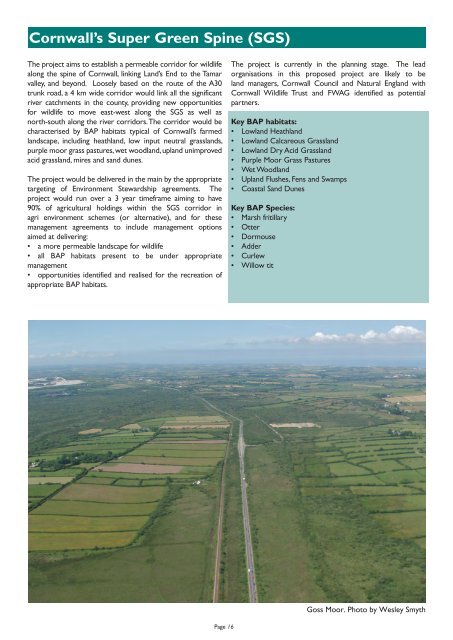Cornwall's Biodiversity Action Plan - Cornwall Wildlife Trust
Cornwall's Biodiversity Action Plan - Cornwall Wildlife Trust
Cornwall's Biodiversity Action Plan - Cornwall Wildlife Trust
Create successful ePaper yourself
Turn your PDF publications into a flip-book with our unique Google optimized e-Paper software.
<strong>Cornwall</strong>’s Super Green Spine (SGS)<br />
The project aims to establish a permeable corridor for wildlife<br />
along the spine of <strong>Cornwall</strong>, linking Land’s End to the Tamar<br />
valley, and beyond. Loosely based on the route of the A30<br />
trunk road, a 4 km wide corridor would link all the significant<br />
river catchments in the county, providing new opportunities<br />
for wildlife to move east-west along the SGS as well as<br />
north-south along the river corridors. The corridor would be<br />
characterised by BAP habitats typical of <strong>Cornwall</strong>’s farmed<br />
landscape, including heathland, low input neutral grasslands,<br />
purple moor grass pastures, wet woodland, upland unimproved<br />
acid grassland, mires and sand dunes.<br />
The project would be delivered in the main by the appropriate<br />
targeting of Environment Stewardship agreements. The<br />
project would run over a 3 year timeframe aiming to have<br />
90% of agricultural holdings within the SGS corridor in<br />
agri environment schemes (or alternative), and for these<br />
management agreements to include management options<br />
aimed at delivering:<br />
• a more permeable landscape for wildlife<br />
• all BAP habitats present to be under appropriate<br />
management<br />
• opportunities identified and realised for the recreation of<br />
appropriate BAP habitats.<br />
The project is currently in the planning stage. The lead<br />
organisations in this proposed project are likely to be<br />
land managers, <strong>Cornwall</strong> Council and Natural England with<br />
<strong>Cornwall</strong> <strong>Wildlife</strong> <strong>Trust</strong> and FWAG identified as potential<br />
partners.<br />
Key BAP habitats:<br />
• Lowland Heathland<br />
• Lowland Calcareous Grassland<br />
• Lowland Dry Acid Grassland<br />
• Purple Moor Grass Pastures<br />
• Wet Woodland<br />
• Upland Flushes, Fens and Swamps<br />
• Coastal Sand Dunes<br />
Key BAP Species:<br />
• Marsh fritillary<br />
• Otter<br />
• Dormouse<br />
• Adder<br />
• Curlew<br />
• Willow tit<br />
Goss Moor. Photo by Wesley Smyth<br />
Page 16

















